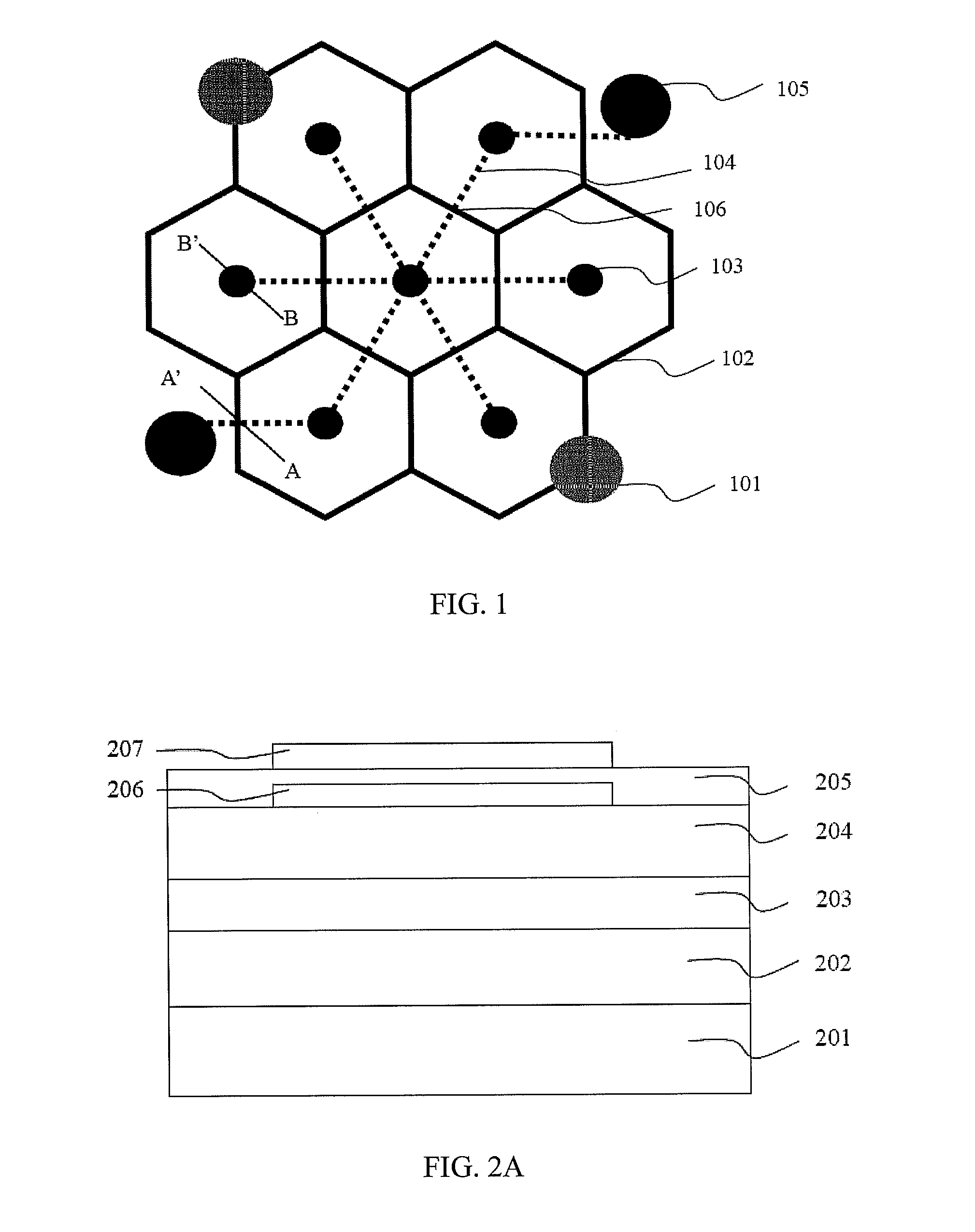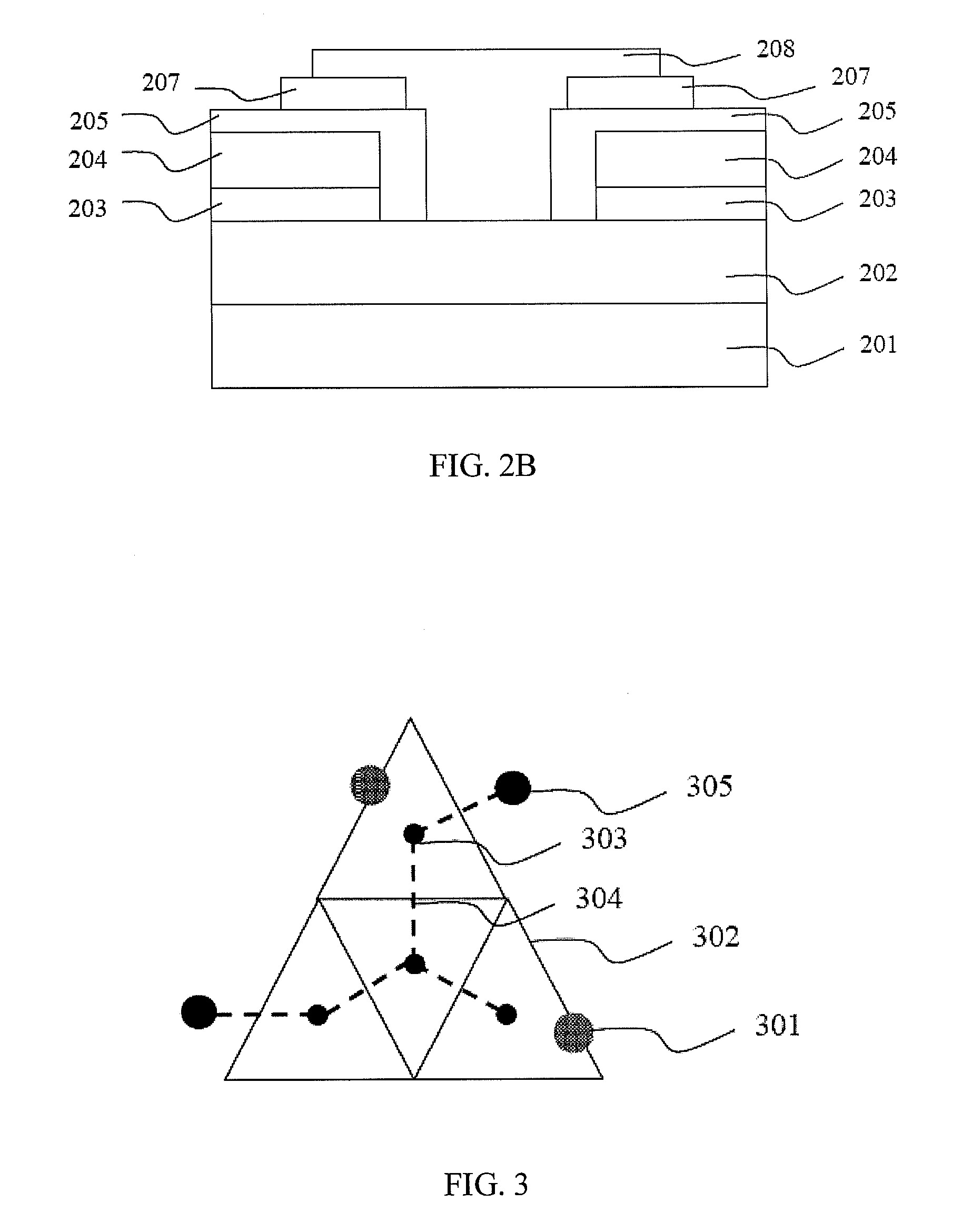Optoelectronic semiconductor device
a semiconductor device and optoelectronic technology, applied in the manufacture of final products, semiconductor/solid-state devices, basic electric elements, etc., can solve the problems of reducing lighting efficiency, affecting the uniformity of light, and damage to lighting devices, so as to achieve stable manufacturing process and low cost
- Summary
- Abstract
- Description
- Claims
- Application Information
AI Technical Summary
Benefits of technology
Problems solved by technology
Method used
Image
Examples
first embodiment
[0025]FIG. 1 shows a top view of the electrode structure of the optoelectronic semiconductor device in accordance with the present application. The device includes at least a p-type bonding pad 101, a plurality of p-type extension electrodes 102, a plurality of n-type contact zones 103, a plurality of n-type extension electrodes 104 and at least an n-type bonding pad 105. The p-type extension electrodes 102 form a plurality of symmetrical closed patterns, and at least a p-type bonding pad 101 is formed on the p-type extension electrodes 102. The n-type contact zone 103 is disposed in the symmetrical closed pattern mentioned above and electrically connected to the plurality of n-type extension electrodes 104. Besides, the p-type extension electrodes 102 and the n-type extension electrodes 104 are electrically connected to the p-type bonding pad 101 and the n-type bonding pad 105 respectively. In this embodiment, the p-type extension electrodes 102 and the n-type extension electrodes ...
fourth embodiment
[0037]FIG. 5 and FIG. 6 illustrate another layout of the electrode structure of the optoelectronic semiconductor device of the present application. FIG. 5 illustrates a top view of the layout of the electrode structure of the optoelectronic semiconductor device in accordance with the present application. The device shown in the drawing including at least one p-type bonding pad 501, a plurality of p-type extension electrodes 502, a plurality of n-type extension electrodes 503, at least an n-type bonding pad 504 and a plurality of insulating layers 505.
[0038]The p-type extension electrode 502 includes a plurality of perpendicular p-type extension electrodes 5021 and a plurality of lateral p-type extension electrodes 5022 to form a plurality of symmetrical closed patterns. A plurality of straight n-type extension electrodes 5031 and a plurality of lateral n-type extension electrodes 5032 are formed at the p-type extension electrodes 502 wherein part of the perpendicular p-type extensio...
fifth embodiment
[0042]FIG. 6 illustrates a top view of the layout of the electrode structure of the optoelectronic semiconductor device in accordance with the present application. The embodiment includes at least one p-type bonding pad 601, a plurality of p-type extension electrodes 602, a plurality of n-type extension electrodes 603, at least one n-type bonding pad 604 and at least one lateral insulating layer 605.
[0043]The p-type extension electrode 602 forms a plurality of symmetrical closed patterns including a plurality of perpendicular p-type extension electrodes 6021 and a plurality of lateral p-type extension electrodes 6022. A plurality of perpendicular n-type extension electrodes 6031 and a plurality of lateral n-type extension electrodes 6032 are formed in the p-type extension electrode 602 wherein a portion of the perpendicular p-type extension electrode 6021 and the lateral n-type extension electrode 6032 form the three-dimensional crossover. At least one p-type bonding pad 601 is form...
PUM
 Login to View More
Login to View More Abstract
Description
Claims
Application Information
 Login to View More
Login to View More - R&D
- Intellectual Property
- Life Sciences
- Materials
- Tech Scout
- Unparalleled Data Quality
- Higher Quality Content
- 60% Fewer Hallucinations
Browse by: Latest US Patents, China's latest patents, Technical Efficacy Thesaurus, Application Domain, Technology Topic, Popular Technical Reports.
© 2025 PatSnap. All rights reserved.Legal|Privacy policy|Modern Slavery Act Transparency Statement|Sitemap|About US| Contact US: help@patsnap.com



